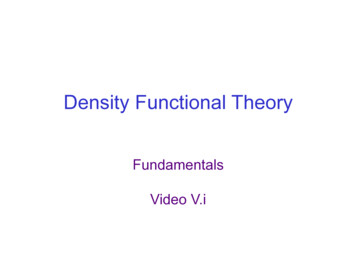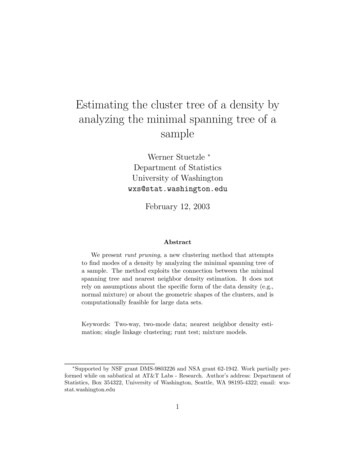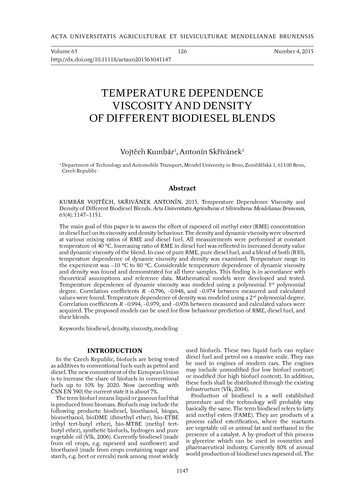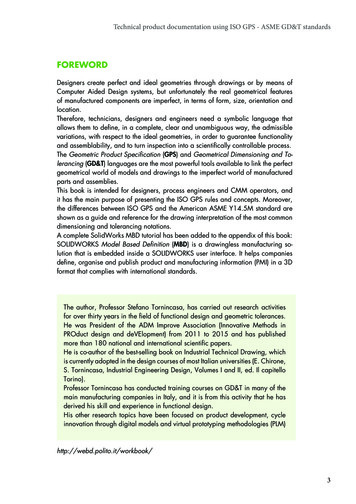
Transcription
Density Functional TheoryFundamentalsVideo V.i
Density Functional Theory: New DevelopmentsDonald G. TruhlarDepartment of Chemistry, University of MinnesotaSupport: AFOSR, NSF, EMSL
Why is electronic structure theory important?Most of the information we want to know about chemistry is in theelectron density and electronic energy.dipole moment,charge distribution,.Born-Oppenheimerapproximation 1927potential energy surfacemolecular geometrybond energiesbarrier heightsspectra
How do we calculate the electronic structure?Example: electronic structure of benzene (42 electrons)Erwin Schrödinger 1925 — wave function theoryAll the information is contained in the wavefunction, an antisymmetric function of 126coordinates and 42 electronic spin components.
Theoretical Musings! Ψ is complicated.Difficult to interpret.Can we simplify things?Ψ has strange units: (prob. density)1/2,Can we not use a physical observable?What particular physical observable is useful?Physical observable that allows us to constructthe Hamiltonian a priori.
How do we calculate the electronic structure?Example: electronic structure of benzene (42 electrons)Erwin Schrödinger 1925 — wave function theoryAll the information is contained in the wavefunction, an antisymmetric function of 126coordinates and 42 electronic spin components.Pierre Hohenberg and Walter Kohn 1964 —density functional theoryAll the information is contained inthe density, a simple function of 3coordinates.
Electronic structure (continued)Erwin Schrödinger 1925 — wave function theoryNobel Prize in Physics 1933Walter Kohn 1964 and continuing work —density functional theoryNobel Prize in Chemistry 1998(with John Pople, for practical WFT)
How do we do the calculation?wave function theoryH Ψ EΨE min Ψ Ψ H ΨΨ trial wave functiondensity functional theory 3 E min n V nuclei (r )n(r )d r F [n(r )]{}n trial density; F universal functional
What’s the problem?wave function theoryH Ψ EΨPaul Dirac 1929: “the difficulty is only that theexact application of these laws leads to equationsmuch too complicated to be soluble.”density functional theory 3 E min n V nuclei (r )n(r )d r F [n(r )]{}We do not even have an equation for F !
Density Functional TheoryEarly ApproximationsVideo V.ii
On what does H depend?! Position and atomic number of the nuclei. Total number of electrons, N. A good physical observable: the electron density Number of electrons per unit volume in a given state is the electrondensity for that state.ρ(r ) N Ψ(r, x 2, ., x N )Ψ(r, x 2, ., x N ) dx 2 .dx N ρ integrated over all space gives N:N ρ(r)dr The nuclei are effectively point charges: Their positions correspond to local maxima in the electron density also cusps.Maxima are
Intuitive Apparent Equivalence! Assignment of the nuclear atomic numbers. The atomic number can be obtained from the electron density. For any nucleus A located at an electron density maximum rA ρ ( rA ) rA r 2Z A ρ ( rA )(1)A 0 ZA: atomic number of A, rA radial distance from A, averaged densityρ (rA ) spherically Of course, we do not yet have a simple formalism for findingthe energy.But, given a known density, one could form the Hamiltonianoperator, solve the Schrödinger equation and determine thewave functions and energy eigenvalues.
Early Approximations! Energy is separable into kinetic and potential components.Use only the electron density to determine the molecularenergy: consider the system as classical:easy to determine the components of the potential energy. Nuclear-electron attractionnucleiVne [ ρ( r)] k Zkρ( r) drr rk(2)Self-repulsion of a classical charge distributionρ (r1 )ρ (r2 )1 Vee [ρ (r )] dr1dr2(3)2r1 r2r1, r2 dummy integration variables running over all space.
Thomas-Fermi Kinetic Energy!I Kinetic energy of a continuous charge distribution.Introduce a fictitious substance “Jellium”: infinite number of electronsmoving in an infinite volume of space with uniformly distributed positivecharge.Also called uniform electron gas (ueg): constant non-zero density.Thomas and Fermi (1927) used fermion statistical mechanics to derivethe kinetic energy for ueg as particles in a box32 2 3Tueg [ρ (r )] ( 3π ) ρ 5 3 (r )dr10 ( 4)T, V are functions of the density, while the density is a function of threespatial coordinates. A function whose argument is itself a function is called a “functional”. T, V are density functionals.
Thomas-Fermi Model! TF equations together with an assumed variational principle,represent the first effort to define a Density Functional Theory.Energy is computed with no reference to the wave-function.No use in modern quantum chemistry: all molecules unstablerelative to dissociation into atoms.Huge approximation in (3) for the interelectronic repulsion: itignores the energetic effects associated with correlation andexchange.Hole function: h corrects for the energetic errors introduced byassuming a classical behaviour.NΨ i j 11Ψ rij2 ρ (r1 )ρ (r2 )1dr1dr2 r1 r22 ρ (r1 )h(r1; r2 )dr1dr2r1 r2(5 )
Hole Function!INΨ i j 11Ψ rij2 ρ (r1 )ρ (r2 )1dr1dr2 r1 r22 ρ (r1 )h(r1; r2 )dr1dr2r1 r2(5 )LHS of (5) is the exact QM interelectronic repulsion.Second term on RHS corrects for the errors in the first term(the classical expression).Hole function h associated with ρ is centred on the positionof electron 1 and is evaluated from there as a function ofthe remaining spatial coordinates defining r2.The value and form of h varies as a function of r2 for agiven value of r1.One electron system: LHS of (5) must be zero.First term of RHS of (5) is not zero since ρ 0 throughoutspace.
Hole Function !II In the one-electron case h is simply the negative ofthe density.In the many-electron case: exact form of h can rarelybe established.h both corrects for self-interaction error (SIE) andaccounts for exchange and correlation energy in amany-electron system.
Slater Exchange!I HF by construction avoids SIE and exactly evaluates theexchange energy (correlation is a problem, though).Slater (1951): one of the consequences of the Pauliprinciple is that the Fermi exchange hole** is larger thanthe correlation hole.Exchange corrections to classical interelectronic repulsionlarger than correlation corrections (one or two order ofmagnitude).Slater decided to ignore correlation corrections, andsimplify the exchange corrections.**:Consequence of the Pauli exclusion principle. Reducedprobability of finding two electrons of the same spin close toone another. Fermi hole surrounds each electron.
Slater Exchange !II Exchange hole about any position: sphere of constantpotential; radius depending on the magnitude of the density atthat position.With this approximation the exchange energy is139α 3 Ex 8 π ρ 4 3 (r )dr In the Slater derivation: α 1. Eq. (6): Slater exchange.( 6)Unit analysis challenge: Satisfy yourself that 4/3 is the properexponent on the density in order to compute an energy. What abouteq. 4 earlier? Is 5/3 correct for kinetic energy?
Xα! Many early workers saw fit to treat alpha as an empiricalvalue.HF calculations employing eq (6) instead of doing exchange“properly” called Xα (or Hartree-Fock-Slater (HFS)).Empirical analysis in a variety of systems suggested thatα 3/4 provides more accurate results than α 1 or α 2/3.DFT (and HFS) models up to this point gave generally largeerrors in molecular calculations and had relatively little impacton chemistry, although the physics community found themuseful because their “locality” facilitates, say, solid-statecalculations.
Density Functional TheoryHohenberg-Kohn TheoremsVideo V.iii
Rigorous Foundation! Hoenberg and Kohn (1964) proved two theorems which establishDFT as a rigorous quantum chemical methodology.Electrons interact with one another and with an externalpotential. Hohenberg-Kohn theorem employs the ground-state density. External potential is the attraction to the nuclei. Integration of the density: number of electrons. It remains to determine the external potential for the real system(charges and positions of the nuclei).The ground-state density uniquely determines the externalpotential.Proof proceeds via reductio ad absurdum.
Hohenberg Kohn Theorem!I Assume that two different external potentials can each beconsistent with the same non-degenerate ground-statedensity ρ0. Call potentials: va and vb. Potentials determine Hamiltonians Ha and Hb. Associate with each Ha and Hb a ground-state wavefunction Ψ0 and eigenvalue E0.Variational theorem: the expectation value of Ha over the wfb must be higher than the ground-state energy of a.E0,a Ψ0,b H a Ψ 0,b( 7)
Hohenberg Kohn Theorem!IE0,a Ψ0,b H a H b H b Ψ 0,b Ψ0,b H a H b Ψ 0,b Ψ0,b H b Ψ 0,b(8 ) Ψ0,b va vb Ψ 0,b E0,b Potentials v are one-electron operators:Last line of (8) can be written in terms of the ground state density: E0,a [v (r) v (r)]ρ (r)dr Eab00,b( 9)No distinction between a and b, we can interchange theindices in (9)E0,b [v (r) v (r)]ρ (r)dr Eba00,a(10)
Hohenberg Kohn Theorem!I Add (9) and (10):E0,a E0,b [v (r ) v (r )]ρ (r )dr [v (r) v (r)]ρ (r)drba0ab0 E0,b E0,a(11) E0,b E0,aassumption that the ground state densitiesassociated with the wave functions a and b are the same permits us to eliminate the integrals as theymust sum to zero. Impossibleincorrect.result:ourinitialassumptionwas
Hohenberg Kohn Theorem!I The non-degenerate ground-state density mustdetermine the external potentialHamiltonianwave function. H determines not just the ground-state wavefunction, but all excited-state wave functions.What utility are the densities of the excited states?HK theorem can be extended to the lowest energy(non-degenerate) state within each irrep of themolecular point group.
Hohenberg Kohn Theorem !II Theorem I: existence theorem. How to get the density of a system? Just as with MO theory: need a way to optimize the energy. HK II theorem: the density obeys a variational principle. Have some well-behaved density: integrate to the propernumber of electrons N.Theorem I: this density determines a candidate wavefunction ΨcandEnergy expectation value:Ψcand H cand Ψcand Ecand E0(12)
Hohenberg Kohn Theorem II cont.! In principle: choose different densities and those thatprovide the lower energies are closer to correct. How do we choose improved densities? We want to avoid solving the Schrödinger equation. How can the density be used in a variational equation todetermine the energy without recourse to the wavefunction?
Density Functional TheoryKohn-Sham (KS) TheoryVideo V.iv
Kohn-Sham Self-consistent field! Trick: Take a fictitious system of non-interacting electronswhere ground-state density is the same density as the realsystem where the electrons interact.Real and fictitious system have the same positions and atomicnumbers of the nuclei (same density)An easy Hamiltonian: a sum of one-electron operators.Eigenfunctions: Slater determinants of the individual oneelectron eigenfunctions (cf. text, Section 4.5.1).Eigenvalues:sum of one-electron eigenvalues (cf. text,Section 4.5.1).
Kohn-Sham Density Functional Theory1965Consider the electronic energy of a molecule:E T Vne Vee VxcNoninteractingkinetic energyWrite densityas a product oforbital densities;compute Tfrom orbitals.Coulombinteractionwith nucleiCoulomb interactionof electron densityρ with itselfElectron cannotinteract with itself.
Kohn-Sham Self-consistent field! Divide energy functional into specific componentsE [ρ (r )] Tni [ρ (r )] Vne [ρ (r )] Vee [ρ (r )] ΔT [ρ (r )] ΔVee [ρ (r )](13) Tni: kinetic energy of non-interacting electrons Vne: nuclear-electron interaction Vee: classical electron-electron repulsion ΔT: correction to kinetic energy ΔVee: all non-classical corrections to el.-el. repulsion energy
KS SCF !II Express the density in an orbital basis set: 1 2E [ρ (r )] χ i i χ i χ i2i NN i 1χi2 nuclei k Zkχ i ri rk (14 )ρ (r')dr' χ i E xc [ρ (r )]ri r'N: number of electrons.Density for a Slater determinantal wf (exact for the noninteracting system)N2ρ(r ) χi (r )(15)i 1
Simplest functional: LSDAlocal spin-density approximationKohn & Sham 1965, von Barth & Hedin 1972Example: for a closed-shell system: Energy TKS Ven Vee d 3r ρ (r ) {ε x [ρ (r )] ε c [ρ (r )]}densityExchange energyof uniform electron gasneutralized by uniformpositive background charge –0.73856 ρ1/3 (from Dirac α 2/3)Correlation energy.Fit to Monte Carlocalculations foruniform electron gas
KS SCF III Difficult terms ΔT and ΔVee are contained in: Exc: exchange-correlation energy. It includes:1) effects of quantum mechanical exchange and correlation2) correction for the classical self-interaction energy3) difference in kinetic energy between the non-interactingsystem and the real one Find orbitals χ that minimize E in (13). They satisfy:hiKS χ i εi χ i (16)KS operator is one-electron operator!nucleiρ ( r')1ZkKS2hi i dr' Vxc 2ri rkri r'k(17)
KS SCF IV Where: E xcVxc ρ(18)Vxc is a functional derivative. One-electron operator for whichthe expectation value of the KS Slater determinant is Exc. Since E (eq (13)) is exact, the orbitals {χ} must provide theexact density (the minimum must correspond to the realsystem).These orbitals also form the Slater-determinantal KSwavefunction for the separable non-interacting Hamiltonian hiNNKSh i χ1χ 2 χ N εi χ1χ 2 χ Ni 1i 1(19)
KS SCF V Use the first term on the r.h.s. of (14) to compute the kineticenergy of the non-interacting electrons.To determine the KS orbitals use the same approach as inMO theory:Express KS orbitals within a set of basis functions {φ},determine the individual orbital coefficients by solution of asecular equation entirely analogous to that employed in theHF theory.Replace the Fµν elements by the the Kµν elementsK µν1 2 nuclei Z k φµ 2r rkk ρ (r')dr' Vxc φνr r'(20)
HF vs DFT ISimilarities between HF and KS Common variational principleKinetic energy and nuclear attraction component of matrix elements of Kare identical to those of F.If the density in the classical interelectronic repulsion operator is expressedin the same basis functions used for the KS orbitals, then the same fourindex electron-repulsion integrals will appear in K as in F.Density required for computation of the secular matrix elements.Density determined using the orbitals obtained from the solution of thesecular equation:KS procedure is a SCF iterative procedure.Historically: modify existing codes for HF calculations to perform DFTcalculations.
HF vs DFT IIKey differences between HF and KS DFT as derived so far contains no approximations: it is exact. But, we need to know Exc as a function of ρ. HK: proved that a functional of ρ must exist. No guidance, though, as to what the functional should look like. Contrast between HF and DFT: HF approximate theory: solve the relevant equations exactly. DFT exact theory: solve the relevant equations approximately because theform of the operator is unknown.Exact DFT is variational. When approximations of Exc are introduced, this isno longer true.Both exact and approximate DFT are size extensive.
Density Functional TheoryKohn-Sham (KS) TheoryLocal (Spin) Density ApproximationVideo V.v
Exchange-correlation Energy Exc: difference between the classical and quantummechanical el.-el. repulsion.It also includes the difference in kinetic energy between thefictitious non-interacting system and the real system.Most functionals do not attempt to compute the K.E.correction explicitly.Either they ignore the term, or construct a hole functionanalogous to that of eq. (5) that also incorporates thekinetic energy difference between the interacting and noninteracting systems, perhaps empirically.
Exchange-correlation (xc) Functionals In many functionals, empirical parametersintroduce some kinetic energy correction based onexperiment.Common notations in the field followFunctional dependence of Exc on ρ expressed asan interaction between ρ and an energy density,that is itself dependent on the electron densityE xc [ρ (r )] ρ (r ) ε [ρ (r)]dr (21)xc
xc Functionals II Energy density εxc is treated as a sum (separable or not) ofindividual exchange and correlation contributions.Slater (or Dirac, or empirical [α]) exchange energy density:139α 3 1 3ε x [ρ (r )] ρ (r )8 π (22)Electron density can also be expressed in terms of aneffective radius such that exactly one electron would be within the sphere defined by that radius were it tocontainedhave the same density throughout as its center 3 1 3rS (r ) (23) 4 πρ (r )
xc Functionals III Spin not considered so far. Use individual functionals of the α and β densities. Spin density at any position is expressed in terms of thenormalized spin polarization:ρ α (r ) ρ β ( r )ζ (r ) ρ (r ) (24)α spin density is one-half of the product of the total ρ and (ζ 1) and the β spin density is the difference between the that value.total rho and
Local Density Approximation LDA: any DFT where the value of εxc, at some position r,can be computed exclusively from the value of ρ at thatposition, i.e., the ‘local’ value of ρ.Functionals derived primarily from the uniform electron gas(uniform density at every position in space).L(S)DA implies that it is the UEG exchange and correlationfunctionals that are employed for molecular calculations.Can be extended to spin-polarized cases (z from eq. (24),“0” and “1” refer to “no-spin” and “all-same-spin” UEG).ε x [ρ (r ), ζ (r )] ε 0x [ρ (r )] (1 ζ ) 4 3 (1 ζ ) 4 3 2 10 ερr ε(){ x [ ] x [ρ (r )]} 132(2 1) (25)
Local Density Correlation Correlation energy: no analyticalfunctional has proven possible.derivationofthisQuantum Monte Carlo: Ceperley and Alder (1980)computed the total energy for fully interacting uniformelectron gases of various densities.Subtract the analytical exchange energy to determine thecorrelation energy.Vosko, Wilk and Nusair (1980): designed local functionalsof the density fitting to these results.Spin-polarized functional analogous to (25), but with theunpolarized and fully polarized correlation energy densities.
Local Density Correlation Different sets of empirical constants. VWN: several fitting schemes varying the functional forms. LSDA that employs a combination of Slater exchange and the VWNcorrelation energy expression: SVWN.Correlation energy functional is very complex.DFT methods are often semiempirical: they include empiricallyoptimized constants and functional forms.Solution of Exc integrals typically not possible analytically.Evaluation of integrals involving exchange and correlation energydensities in DFT is done numerically on a grid. Use of efficient quadrature schemes. In modern codes: default grid unless otherwise specified by the user.
KS-SCF Procedure In HF theory: Number of Coulomb integrals requiring evaluation isN 4.In DFT it can be reduced to N3, N number of KS AO basis functions.After basis set and molecular geometry choice, the overlapintegrals, kinetic-energy, and nuclear-attraction integrals arecomputed. Same in HF and DFTHF: construct a density matrix and then compute the two-electronintegrals: Coulomb and exchange. DFT: construct a density matrix and also construct Vxc Evaluate the remaining integrals in each KS matrix element. After this point KS and HF SCF are identical.
KS-SCF Procedure II New orbitals are determined from solution of the secular equation.Density is determined from these orbitals and compared with density of theprevious iteration.When SCF procedure is converged: compute the energy by using the finaldensity plugged into eq (14).Cf. HF, where the energy is evaluated as the expectation value of the Hoperator acting on the HF Slater determinant.Geometry optimization? Determine whether the structure corresponds to astationary point.Using the LSDA approximation means that:The exchange-correlation energy density at every position in space for themolecule is the same as that for the uniform electron gas having the samedensity as is found at that position.
LSDA enjoyed early success in physics.The local spin-density approximation “gives bond lengths andthus the geometries of molecules and solids typically with anastonishing accuracy of 1%.”– W. Kohn (Nobel lecture, 1998)But LSDA molecular energies have systematic errors.In rest of lecture: Results are given for representative or large databasesand reasonable basis sets; details in papers.Mean (unsigned) errors in e-Fock theory319Local spin-density approximation1618
Density Functional TheoryKohn-Sham (KS) TheoryGeneralized Gradient ApproximationVideo V.vi
Next step: add gradient dependence.F LSDA F [ρ (r )]Local spin-density approx.Gradient expansion F F LSDA 1 µs2 higher - order ρs constant 4 3ρknown: Antoniewicz & Kleinman 1985Later slide: a second order method with this correct µ SOGGA
Density Gradient Corrections In a molecule the electron density is not spatially uniform. LDA has serious limitations for energies, although it gives good geometries. Improve functionals by making them depend on the extent to which the density islocally changing, i.e. the gradient of the density.Functionals that depend on both the density and the gradient of the density: gradientcorrected or generalized gradient approximation (GGA) functionals.Most GGA functionals are constructed with the correction being a term added to theLDA functionalε GGAx /c[ρ (r )] εLSDx /c ρ (r ) [ρ (r )] Δε x /c ρ 4 3 r ( ) (28)verify that this term isdimensionless x/c: same functional for either exchange or correlation. The dependence of the correction term is on the dimensionless reduced gradient.
Density Gradient Corrections II Most popular GGA exchange functional to date: Becke 1988 (B). (23,000 citationsin March 2013)Correct asymptotic behaviour at long range for the energy density and incorporatesa single empirical parameter.Value of the parameter optimized by fitting to the exactly known exchange energiesof six noble gas atoms (from He to Rn).Other exchange functionals similar to Becke: CAM(B), PW, FT98, mPW.Alternative GGA exchange functionals have been developed based on a rationalfunction expansion of the reduced gradient. They contain no empirically optimizedparameters: B86, P, PBE.Correlation functionals: P86 (Perdew 1986); PW91 (Perdew Wang 92).LYP correlation: (Lee, Yang, Parr 1988) does not correct the LDA expression butcomputes the full correlation energy.It contains four empirical parameters fit to helium atom. It is a correlation functionalthat provides an exact cancellation of the self-interaction error in one-electronsystems.
Progress: GGAsFGE FLSDA[2](ρ ) 1 µs higher - order] ρs constant 4 3ρcorrect µ 0.1235 : “Gradient expansion” F GGA F (ρ , s)incorrect µ : “Generalized gradient approximation” Examples: BLYP (1988)PBE (1996) µ 0.2743µ 0.2195GGA
Generalized gradient approximation shows promise.Mean (unsigned) errors in kcal/molBondenergiesBarrierheightsHartree-Fock theory319Local spin-density approximation1618Correct thru 2nd order: SOGGA7131.58GGA: BLYP (1988)Becke-Lee-Yang-ParrThis aroused the attention of many quantum chemists.
Density Gradient Corrections III Taylor-function-expansion justification for the importance of the gradient. “Obvious” next step: include second derivative of the density, i.e. the Laplacian. Becke and Rousell proposed an exchange functional (BR). Proynov, Salahub, and co-workers examined the same idea for the correlation functional (Lap). Meta-GGA because they go beyond the gradient correction. Alternative Meta-GGA formalism, numerically more stable is to include in the exchangecorrelation potential a dependence on the kinetic-energy density τ:occ21τ ( r) ψ i ( r)i 2 (29)Functions ψ are the self-consistently determined KS orbitals.Some examples of MGGA functionals for exchange, correlation, or both, are B95, B98, ISM,τHCTH, and the Minnesota local functionals M06-L and M11-L. Cost of MGGA comparable to that for GGA. MGGA generally more accurate than GGA.
Density Functional TheoryKohn-Sham (KS) TheoryAdiabatic Connection (Hybrid Functionals)Video V.vii
Adiabatic Connection Methods Posits controlling the amount ofinteraction in a many-electron system.electron-electronA switch that smoothly converts the non-interacting KSreference system to the real, interacting system.Thus, clearly the exchange-correlation energy can becomputed as1E xc Ψ (λ ) Vxc Ψ (λ ) dλ(30)0 Where lambda describes the extent of interelectronicinteraction: 0 (none) to 1(exact).
Adiabatic Connection Methods II1E xc Ψ (λ ) Vxc Ψ (λ ) dλ(30)0 Non-interacting limit: only component of V is exchange(from antisymmetry of the wf). Slater determinant of the KS orbitals is the exact wavefunction for the non-interacting Hamiltonian operator.Expectation value: exact exchange for the non-interactingsystem. Compute as in a HF calculation. Use KS orbitals.Area of the rectangle defined by integration in next slide isthus ExHF
Adiabatic Connection Methods III–E1(1, Ψ(1) Vxc Ψ(1) )E xc (0, Ψ(0) K Ψ(0) ) Ψ( λ) V xc Ψ( λ) dλ0 Area that wewantArea exactexchangecorrelation energy(1, Ψ(0) K Ψ(0) )Area HFexchangeenergy01λ
Adiabatic Connection IV Area that we want: fraction z of the area of the rectangleabove, which itself has areaΨ (1) Vxc (1) Ψ (1) E xHF ( 31)We do not know z. Consider it as an empirical parameter tobe optimized. Approximatethe right endpoint with E computed withxcsome choice of DFT, so area of top rectangle is ExcDFT Total area under the curve.DFTE xc E xHF z( E xc E xHF ) (32)
Adiabatic Connection VDFTE xc E xHF z( E xc E xHF ) In practice (32) is written using another variable a 1–z (32)E xc (1 a) E xcDFT aE xHF( 33)Analysis forms the basis of the ‘adiabatic-connectionmethod’because it connects between the non-interacting and fully interacting states.
Adiabatic Connection VI If expectation value of the curve is a line, then z 0.5: Thisdefines the “Half and Half” method (H&H).Using LDA exchange-correlation, Becke (1993) showedthat the H&H method has an error of 6.4 kcal/mol forenthalpy of formation of the G1 test set.Estimate a in a better way: perhaps include additionalparameters if warranted.Becke (1993) developed a 3-parameter functional (B3).E xcB3PW 91 (1 a) E xLSDA aE xHF bΔE xB EcLSDA cEcPW 91(34 )
Adiabatic Connection VIIE xcB3PW 91 (1 a) E xLSDA aE xHF bΔE xB EcLSDA cEcPW 91 (34 )Where a,b,c were optimized to 0.20, 0.72, 0.81.The name B3PW91: three-parameter scheme, GGAexchange, correlation functionals B and PW91.Model modified to use LYP instead of PW91 by Stephenset al. LYP is designed to compute the full correlation energyand not a correction to LSDA
Adiabatic Connection VIII B3LYP model is defined asE xcB3 LYP (1 a) E xLSDA aE xHF bΔE xB (1 c) EcLSDA cEcLYP ( 35)a,b,c same values as in B3PW91.Of all the modern functionals B3LYP has proven the mostpopular to date, although its reign seems to be ending.Adiabatic Connection methods incorporate both HF andDFT: hybrid methods (including HF means N4 scaling).
Mix GGA with Hartree-Fock exchange.Kohn-Sham theory (1965) – equation for orbitals: Fc ϕ i εiϕ i ρ Fx T Vne Vee ρ Compare Hartree-Fock theory (1930): ()T Vne Vee V HF ϕ i εiϕ ixAdvantages: Attractive HF exchange cancels self-interaction in VeeHybrid DFT (Becke 1993): X HFX Fx Fc V (1 ) ϕ i εiϕ i T Vne Vee 100 x100 ρ ρ (39,000 citations in March 2013)
Hybrid DFT was a breakthrough.Mean (unsigned) errors in kcal/molBondenergiesBarrierheightsHartree-Fock theory319Local spin-density approximation1618Correct thru 2nd order: SOGGA713GGA: BLYP (1988)1.58Hybrid: B3LYP (1993)0.94Becke–3 parameter–Lee-Yang-Parr“chemical accuracy” formain-group bond energies,bond lengths, .This was the tipping point—making DFT the accepted everyday tool.
B3LYP is enormously popular.HSousa, Fernandes, Ramos, JPC A (2007)
Density Functional TheoryWrap-upVideo V.viii
DFT versus MO theory DFT optimizes an electron density while WFT theory optimizes a wave function. To determine a molecular property: In DFT: how does the property depend on the density? In MO theory: need to know the quantum mechanical operator. WF has a broader utility because there are more well-characterized operators thanthere are generic property functionals of the density.Example: total energy of interelectronic repulsion:Even if we had the exact density, exact exchange-correlation energy functional notknown: exact interelectronic repulsion cannot be computed.With the exact wave function, evaluate the expectation value for the interelectronicrepulsion operator1Eee Ψ Ψi j rij(36)
DFT versus MO theory II There is a DFT wave function. How useful is it?Slater Determinant from the KS orbitals is the exact wave function for the fictionalnon-interacting system having the same density as the real system.Properties of the KS determinants: extremely low level of spin contamination, evenfor cases where HF behaves badly.It is by no means guaranteed that the expectation value for S2 over the KSdeterminant has any relationship at all to the corresponding expectation value overthe exact wave function that corresponds to the KS density.Empirical observation suggests that DFT is more robust in dealing with open-shellsystems where HF shows high spin contamination.In WFT methods, ex
The value and form of h varies as a function of r 2 for a given value of r 1. One electron system: LHS of (5) must be zero. First term of RHS of (5) is not zero since throughou space. Ψ 1 i j r ij N Ψ 1 2 ρ(r 1)ρ(r 2) r 1 r 2 dr 1 dr 2 1 2 ρ(r 1)h(r 1;r 2) r 1 r 2











